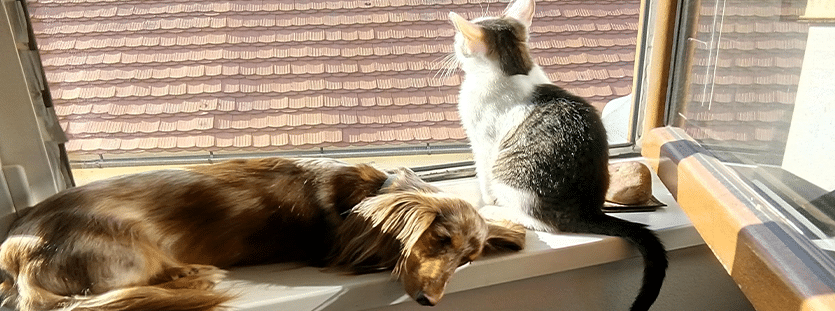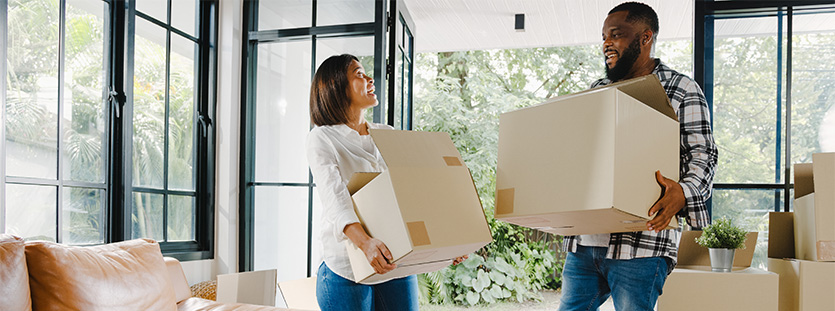Moving abroad can be stressful for everyone, and that includes moving your pets. Animals will find adapting to a new environment very daunting. If your pet spends a lot of time roaming outside, they will be confused when being taken away from their normal area, normal routine, it’s a shock to their system. This can cause them to get lost and agitated because they don’t know where they are, who their neighbours are or how to get home.
We have helped numerous customers move their pets safely around the world, and have found that preparation is key to helping your pets to remain calm before, during and after the move. It will also help your pet to settle quickly into their new home.
How to settle a dog into a new home:
- Once you’ve moved, bring familiar belongings such as a blanket, toy, and pillow into the room where your dog will spend the most time, they will still have your dog’s scent on them so they will know they’re theirs.
- Pet protect your new home using gates on the stairs so they can’t go up them and make sure any fencing in the garden is secure so they can’t escape.
- Make sure you explore your new area safely and always use a leash
- Reinforce positive behaviour, rewards for good things.
- Try to follow the same routine in your new home as you did in your old home, e.g., going for walks at the same time of day, food at the same time, getting up and going outside in the morning for the toilet.
- Don’t buy new dog gear such as bowls, beds and blankets as your dog will struggle to adjust to their new surroundings without the comforts of their old home.
- Don’t leave your dog home alone straight away after you’ve moved, it will unsettle them. They need to learn to be without you in an unfamiliar space.
- Be patient with your dog, they may be anxious, have low moods, less likely to play as they are in a new space, give them time and they will return to their old familiar ways once they are settled.
- Get a new tag sorted with the correct details so that if they get lost people can easily contact you rather than not being able to reach you and returning the dog.
Knowing how to recognize your dog’s anxiety when moving into a new home can be difficult but there are a few signs to look for: aggression, urinating or defecating in the house, excessive barking, panting, drooling. To help them cope with this anxiety you should plan to only be away from them for a short time after you move, try, and plan it for when they are most likely to be sleeping or resting so they won’t notice whether you’re there or not. Also don’t drag out saying goodbye to your dog as it will only make it worse, give them a treat, say goodbye, and then leave.
How to deal with a cat traumatized by moving home:
- Much like dogs’ cats are unsettled by moving to a new space as usually they spend hours outside and can find their way home easily, they know their local areas so moving to a new place can throw them off guard.
- When the move is taking place and the cat is present, make sure they are either in a cat carrier or secured in a room so that they can’t get out. You don’t want your cat to be able to get into the moving van as you’ll then have to try and get it brought back to you.
- Make sure to bring the cat inside at least 1-2 weeks before your me so that they get used to being inside, this way they won’t find it difficult when they are being transported and possibly quarantined.
- Change your cat’s association with their cat carrier to be a positive rather than a negative.
- Leave the carrier in their favourite area.
- Have fun in and around the carrier so they know it’s a positive space.
- Feed your cats treats while they are in the carrier so that they know it’s a positive place.
- Place toys in the carrier along with their favourite towel or blanket so they can be comfortable and want to spend time in there.
- Reduce their anxiety by placing empty boxes around the house a week before you move giving them a chance to explore them and getting used to having boxes encroached in their space for a small period.
- Plug in a calming diffuser or try calming remedies to help relieve stress
- When in the new home it’s best to expand the cat’s territory slowly so that they can get used to the new area.
- Get a new tag for their collar so if they get lost people know who to contact.
Using a trusted pet relocation service is the best way to move your pet, the process can take a few months so get started on this process early as you’ll need to ensure any vaccination and paperwork are done before they move.
You can also talk to the International Pet & Animal Transportation Association (IPATA) who will be able to give you advice on who is best suited to help you with your pet relocation. They can also support and guide you throughout the process. Working with these services will ensure you follow the rules and regulations of the destination country.
Here, at GMS, we know that your pet is part of the family and should be treated as such – contact us for further advice and a free no-obligation quote on moving your pet by calling +44 (0) 20 7097 5335.








